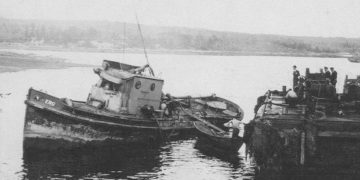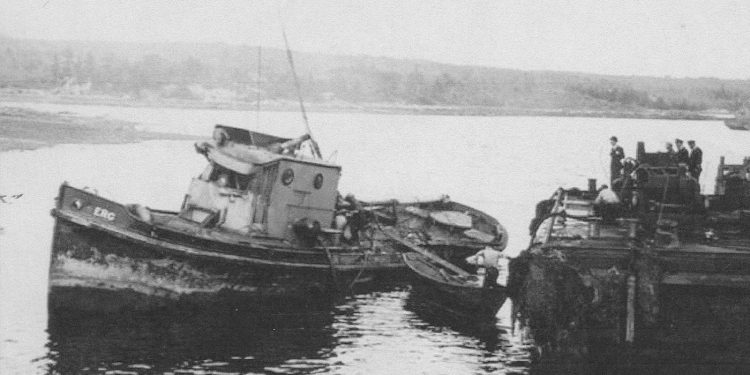This is one of many tales of disaster that lay beneath the waters of the Bedford Basin.
The tragic story of the ‘Erg’ started at the Halifax Shipyard where it was built in 1915. It was one of the earliest steel vessels built in Halifax and was owned by the Halifax Shipyard. The steam tug was at first named the Sambro and was fifty-five feet long and fifteen feet wide with a depth of seven feet and had a maximum tonnage of twenty-eight. During the Halifax Explosion on Dec. 6, 1917, while docked at the Graving Dock Wharf on the Halifax side of the harbour, the force from the Explosion sank the Sambro to the bottom of the harbour. The Explosion occurred only 300 metres (980 ft.) north of the Graving Dock and many yard workers were killed. The Sambro was raised from the water in 1927 and renamed the ‘Erg’. The vessel had a diesel engine installed to become a work boat, ferrying workers and their equipment to vessels under repair.
There is an old saying, “Let sleeping dogs lie!” The vessel should have been left where she lies in her watery tomb. Historically it has been considered bad luck to change the name of a boat without a purging and renaming ceremony that must be completed before the new name is revealed or anything with the new name on it put aboard the boat. Sailors, since the dawn of time, have sworn that the unluckiest ships are those who have changed their names. The Erg was then equipped with air compressors and electric generators to support welding and pneumatic tools. During the Second World War the vessel played a very important role in assisting with the movement and repair of larger ships. The Shipyard workers on the tug consisted of electricians, carpenters, iron workers and other tradesmen. Activity on the Halifax Harbour and the Bedford Basin were extremely busy at that time with ships going to and from the port at all hours, so it was not surprising that many accidents happened on the water surface.
On the foggy, rainy morning of July 6, 1943, at 9 o’clock, the Erg carrying workers and equipment, was on its way to service a Merchant Marine Ship, anchored in the Bedford Basin with an assembled convoy, when it was hit by a Norwegian freighter called the Norelg, a larger ship weighting in at 3,382 tonnes. The Erg was struck from behind and did not stand a change when the big freighter, with her steel sides towering high above, crumbled the little tug on the port side and completely tipped her over, sinking her within six minutes. The accident happened in seventyfive metres of water in the central area of the Bedford Basin. There were twenty-four men aboard and only five survived, a few were able to escape through the only exit door leading from the wheelhouse and the other nineteen men were trapped in the wheelhouse and the engine room below the deck and because of the speed in which the vessel sank, many did not have time to escape and drowned. Stories were told by survivors of heroic attempts by men who were struggling to stay afloat themselves in the rain swept water, while attempting to save others.
It was the worst harbour tragedy since the Halifax Explosion on Dec. 6, 1917.
On July 19, 1943, the Royal Canadian Navy used a floating crane to raise the Erg from the water and it was towed and beached near the South Jetty of the Navy Magazine, on the eastern side of the Bedford Basin. There they were able to recover ten bodies of the workers but the other nine were never found. Three weeks after the Erg sunk, the Federal Minister of Transport selected Judge John A. Barry to oversee an investigation under the Canadian Shipping Act. He found that the crew of Norwegian freighter called the Norelg were guilty of negligence in failing to have a lookout posted.
The Erg hull was too severely damaged to repair, so the tug was taken to the shallow end of the basin in Roach Cove, north of the magazine and there she was scuttled and sunk for the third and last time on August 24, 1943.
After the discovery with side scan sonar, divers from the Nova Scotia Underwater Exploration Society found the wreck of the Erg in October 2000. The sunken vessel was fully intact.
The site was proclaimed a Protected Heritage Site under the Special Places Protection Act and divers placed a plaque beside the wreck.
The plaque read:
PROTECTED HERITAGE SITE under the SPECIAL PLACES PROCTECTION ACT Dedicated to the memory of the nineteen men who lost their lives with the sinking of the Halifax Shipyard tug “ERG” on July 6, 1943, in collision with freighter S.S. “NORELG” Memorial plaque donated by Halifax Shipyard IRVING
























